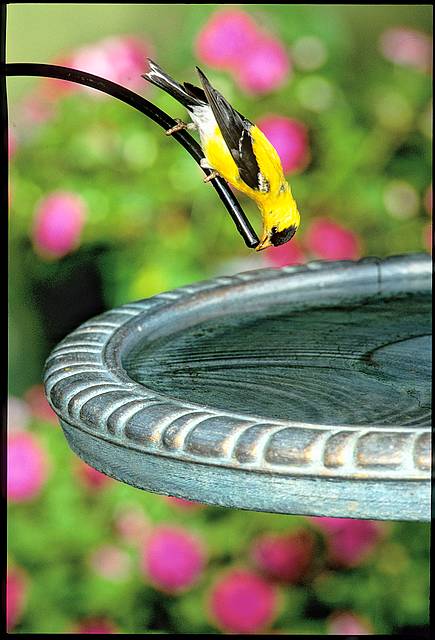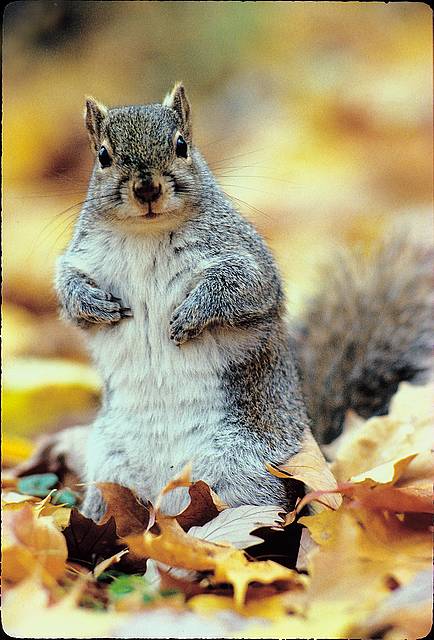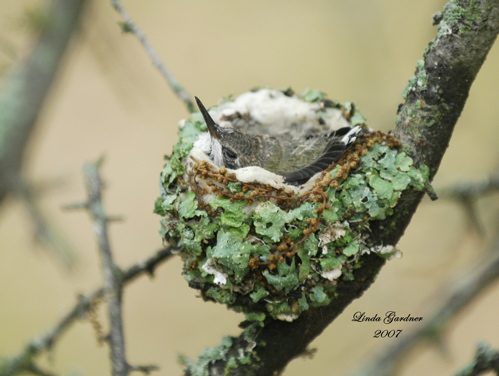-
habitat and thistle feeders for Goldfinches
 Although American Goldfinches are a rather common songbird, it’s a favorite of many backyard birders. With a nickname of “yellow canary” the summer plumage of male Goldfinches is almost electric! Keeping thistle feeders out year-round will almost ensure that vibrant yellow color will grace your yard in warmer months.
Although American Goldfinches are a rather common songbird, it’s a favorite of many backyard birders. With a nickname of “yellow canary” the summer plumage of male Goldfinches is almost electric! Keeping thistle feeders out year-round will almost ensure that vibrant yellow color will grace your yard in warmer months.Habitat plays an important role in attracting any wildlife, and sometimes doing less work is better than doing more. Dandelions happen to be a favorite of goldfinches’, as are spent marigolds, cosmos, zinnias and coneflowers. Don’t dead-head these flowers, better off to leave them as treats for birds to feast.
Water is another key element in attracting finches or any wildlife for that matter. Fresh water in a birdbath will always provide an excellent resource for my species of birds. Keep a fresh water source near thistle feeders to further entice Goldfinches to your place.
Because their nesting and breeding starts so late in the season, you can expect a great increase of activity at thistle feeders in July and August. Parents feed chicks thistle exclusively, so feeders can get rather crowded. And because of their sweet nature, a Goldfinch is more likely to fly away from a crowded thistle feeder than to fight for a perch. If you’d like to attract these super-sweet songbirds, you may want to consider adding an extra thistle feeder in your yard this season.
-
squirrel proof bird feeders… for a while anyway
 Even though we feed our squirrels, it’s just never enough food. And let me tell you, our crafty critters have learned how to defy gravity… spinning at the speed of sound on one of our squirrel proof bird feeders. I don’t know how they do it, but hanging on for dear life seems worthy of a few seeds to them?? It never ceases to amaze me that they don’t just fall over flat when the ride’s through. I think the birds really got a kick out of watching them too
Even though we feed our squirrels, it’s just never enough food. And let me tell you, our crafty critters have learned how to defy gravity… spinning at the speed of sound on one of our squirrel proof bird feeders. I don’t know how they do it, but hanging on for dear life seems worthy of a few seeds to them?? It never ceases to amaze me that they don’t just fall over flat when the ride’s through. I think the birds really got a kick out of watching them tooThey’re constantly trying to outwit every single one of the bird feeders, but always foiled by the ones set up with baffles. Setting up a new feeder on the back deck so I could catch some close-up views from the kitchen and breakfast room window was a great idea in theory.
A hopper seed feeder hangs from a deck bracket. In between the two, a motorized squirrel baffle that is weight-sensitive. At first the spinning feeder would cause the squirrels to want “off” this ride. But after a while, they got use to it and learned to hang on, and even manage a seed or two during the wild ride.
Eventually I gave up and moved the feeder away from the deck and hung it on a pole with a baffle. This solved the problem and still allowed for close-ups of feathered friends. Squirrel baffles, when properly placed, will turn any feeders into true squirrel proof bird feeders… once and for all!
- Bird Accessories, Bird Feeders, Bird Nesting Materials, Hummingbird Feeders, Nesting Material, Uncategorized, Window Hummingbird Feeder
add this near your window hummingbird feeder
 With the hummingbird migration in full swing, it won’t be long before the tiny sprites are in your neck of the woods. Already spotted in LA, SC, TX and all along the Gulf Coast, its just a few short weeks before they’ll infiltrate up the East Coast and Midwest, ultimately reaching Alaska, British Columbia and Canada.
With the hummingbird migration in full swing, it won’t be long before the tiny sprites are in your neck of the woods. Already spotted in LA, SC, TX and all along the Gulf Coast, its just a few short weeks before they’ll infiltrate up the East Coast and Midwest, ultimately reaching Alaska, British Columbia and Canada.Aside from your hanging or window hummingbird feeder, you can further entice hummers with moving water such as birdbath fountains and bubblers, and of course, nesting material.
The Hummer Helper nesting material has been tested and proven to increase the numbers and activity of hummingbirds at your feeders. How you might ask? Because if suitable nest sites are found in your yard, juveniles will also visit feeders, including your window hummingbird feeder. If nectar is always kept fresh, and there’s an enticing water feature, you can bet the same hummingbirds will be back next year! They’re known to practice “site fidelity” meaning that attractive diggs will remain their site of choice the following year. Hummer Helper Nesting Material has even been endorsed by The Hummingbird Society for its effectiveness at promoting nesting by hummingbirds.
Hummingbirds aren’t the only ones who will use this nesting material either, American Goldfinches also adore the white fluffy stuff and will use it for their nesting season in late June through July.
Encourage nesting in your yard through wildlife-friendly habitat. Food water and shelter are the keys, whether natural or man-made. Nectar-producing flowers provide food, while shrubs help with predator protection and provide nesting spots, these will attract many species of wild birds. Water is the best way to attract even more feathered friends too. Mature trees, fruit or berry-producing trees, and even brush piles serve many wild birds well. Never throw out or burn garden debris, if space allows, use it to create brush piles in the back of the yard… your wildlife will thank you for this valuable and natural cover!

